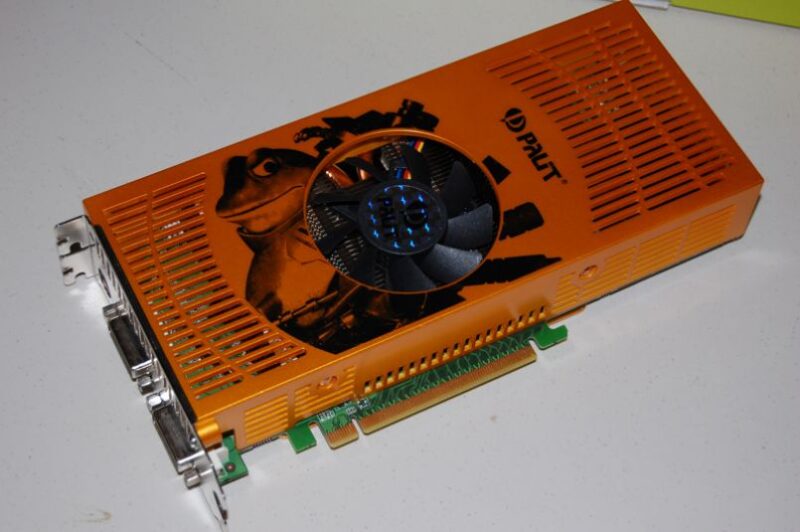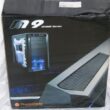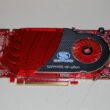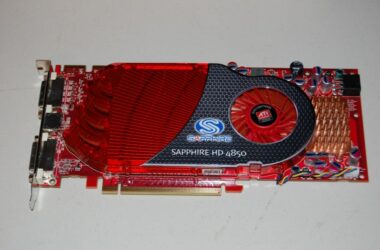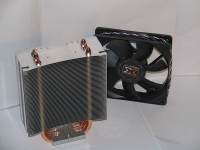Introduction
Chances are that most of our readers have never heard of Palit, therefor believing it to be a new company. Contrary to that thought, Palit is the second largest graphics manufacturer in the world. Palit controls about 40% of the market in Europe, and 60% in China, having only recently come to the United States. Palit has built its reputation by building relationships with its customers and manufacturing superior products by improving references designs from both AMD and nVidia.
Palit recently sent us the GeForce 9600GSO Sonic, which is an enhanced GeForce 9600GSO. Palit has added its own cooler, as well as factory overclocked the unit, and improved upon the power phases. The 9600 GSO is nVidia’s latest foray in the mid-level 9000 series of GeForce cards, and is also the cheapest for a performance card. Despite the price point, the 9600 GSO should be a fair competitor to both the GeForce 9600 GT and Radeon HD3650.
Packaging and Contents
The Palit 9600 GSO Sonic shipped in a green box, stylized with Palit’s robotic frog avatar on the front of the package, as well as the logos for Palit, nVidia, and the GeForce series. Stamped on the front is also the information regarding the 9600 GSO Sonic, such as that I’m looking at the model with 768MB of RAM.
The rear of the box lists the unit’s specifications in various languages, as well as a few additional certifications near the bottom.
Inside, I found the card itself held by a cardboard holder, and wrapped in bubble wrap. Many of manufacturers use anti-static wrap to protect their products, but I think the bubble wrap adds an extra something to the protection.
Under the card were various accessories: HDMI dongle, S-Video and component adapters, power connector, and a VGA dongle. Also included is a small brochure and driver CD.
Let’s look at the card before installing it in our test system.
Appearance
The Palit GeForce 9600 GSO is a dual-slot videocard, and a vented cover on the card makes this fact blatantly apparent. The metallic cover reveals a Palit-branded fan in the center, as well as Palit’s robot frog avatar pictured on the top.
The rear of the card has two DVI ports and an S-Video out as well, like many other cards. I was disappointed not to find any HDMI or DisplayPort connections built into the card, but the HDMI dongle remedies this issue.
The opposite side reveals a single six-pin PCI-Express power connection. Only the high-end models of the GeForce 9×00 family require the eight-pin connection.
The side opposite the PCI-Express connection reveals some of the heatsink’s copper heatpipes. Not many videocards come standard with copper heatpipes and a massive heatsink. Also visible here are the unit’s SLI connection and a SPDIF connection for running audio through the HDMI.
The under side of the card reveals some of the circuit board and various serial and product numbers, but also the heatsink’s mounting base. Compared to other cooling solutions, this base seems massive.
Before installing the card, again, let’s look at the card’s features and specifications to get a grasp on the hardware at hand.
Features & Specifications
The Palit 9600 GSO 768MB comes with a fantastic feature set, and should do well for both videos and gaming.
Features
- Full Microsoft DirectX 10.0 Shader Model 4.0 support
- Dual Dual-link DVI support 2560×1600 resolution displays
- nVidia PureVideo HD Technology
- Certified for Microsoft Windows Vista
- nVidia SLI ready
- HDMI function through DVI-HDMI dongle and SPDIF cable
- HDCP capable
Unlike the Radeon HD3870 Ultimate and Toxic, the GeForce 9600 GSO doesn’t support DirectX 10.1. This isn’t a giant issue, as nVidia is apparently waiting for the next big release of DirectX, and not an incremental release.
Specifications
- Bus interface: PCI Express 2.0 Support
- Memory: 768MB
- Memory Interface: 192 bit
- Core Clock: 600MHz
- Memory Clock: 1800MHz (900×2)
- Shader Clock: 1500MHz
- RAMDACs: 400 MHz
- NVIDIA® unified architecture with GigaThread™ technology
- Full Microsoft® DirectX® 10 Shader Model 4.0 support
- PCI Express 2.0 Support
- 16x full-screen anti-aliasing
- True 128-bit floating point high dynamic-range (HDR) lighting
- NVIDIA® Quantum Effects™ physics processing technology
- Two dual-link DVI outputs support two 2560×1600 resolution displays
- NVIDIA® PureVideo™ HD technology
- OpenGL® 2.1 support
- NVIDIA ForceWare® Unified Driver Architecture (UDA)
- Built for Microsoft® Windows Vista™
- NVIDIA® Lumenex™ Engine
- NVIDIA® nView® Multi-Display Technology
- Discrete, Programmable Video Processor
- Hardware Decode Acceleration
- Spatial-Temporal De-Interlacing
- High-Quality Scaling
- Inverse Telecine (3:2 & 2:2 Pulldown Correction)
- Bad Edit Correction
- Video Color Correction
- Integrated SD and HD TV Output
- Noise Reduction
- Edge Enhancement
- HDMI function through DVI-HDMI dongle and SPDIF cable
Let’s compare some of these specifications to those of the base 9600 GSO.
- 768MB of RAM compared to 384MB
- 600MHz Core Clock compared to 550MHz
- 1800MHz Core Clock compared to 1600MHz
- 1500MHz Shader Clock compared to 1375MHz
Hopefully I’ll find a large performance increase over the base model 9600 GSO, and maybe performance close to that of the Radeon HD3870.
Installation
As with most videocards, installation was a snap. Press the card in, and screw in the PCI bracket to secure. Don’t forget the 6-pin PCI-Express power connection.
One issue I ran into was motherboard-related. The SATA connectors, all six of them, were placed adjacent to the PCI slot directly under the PCI-Express x16 slot. Thusly, the Palit GeForce 9600 GSO blocked all the ports. Thankfully, I was able to fit one SATA cable in, even if it was bending the slot a little.
With the physical installation complete, all that was left was to install the latest nVidia drivers in both Linux and Windows. In Windows, I snagged the latest drivers from nVidia’s homepage. In Linux, I merely installed the latest set from Gentoo’s repository, which just so happened to be the latest available.
Benchmark Setup
I’ll be using the same system I’ve used in previous videocard reviews, and the system will be running both Windows Vista Business 64-bit with Service Pack 1 and Gentoo Linux 2008.0 64-bit. I’ll look at some of the latest games in Windows, and look at a few similar benchmarks in Linux including results from the Phoronix Test Suite.
| Component | Part | |
|---|---|---|
| Processor | AMD Phenom 9500 | |
| Motherboard | Sapphire PI-AM2RS780G 780G | |
| RAM | 2GB DDR2 PC2-8500 Reaper HPC CrossFire Certified | |
| Video Card | Palit GeForce 9600 GSO 768MB | |
| Chassis | Microfly X-Qpack | |
| CPU Cooling | Scythe Katana II | |
| Hard Drive | Excelstor 250GB SATA2 | |
| Power Supply | Antec SmartPower 500W Modular PSU | |
| Display | 1280×1024 | |
| Operating System | Windows Vista Business SP1 64-bit / Gentoo 2008.0 64-bit | |
That said, I’ll be able to compare the 9600 GSO directly against the Radeon HD3870 Ultimate and Toxic I reviewed previously. Let’s get started with the Windows benchmarks. I’ll be looking at performance in 3dMark06 and Vantage, Unreal Tournament 2004, Unreal Tournament 3, Crysis, Quake 4, and Half-Life 2.
Windows Benchmarks
I started off the benchmarking process with some of our typical gaming benchmarks. Once again, I’m testing with Windows Vista 64-bit with Service Pack 1. As we’ve seen with previous reviews, Windows Vista really hits hard when it comes to gaming performance. The 32-bit version shows decrease in FPS in most games, but the 64-bit version shows an even greater decrease. Many of these cards we test with are capable of much higher framerates, but, well… it’s 64-bit Vista.
Unreal Tournament 2004
Since a Linux port of Unreal Tourmanet 3 has yet to be released for Linux, I use Unreal Tournament 2004 as a benchmark to compare Linux and Windows performance from videocards and processors. Although an older game, the framerate is still a good determining factor of how good a videocard is. I tested Unreal Tournament 2004 with everything set the maximum settings, at our default resolution, 1280×1024. I’m also using the OpenGL rendering engine, as that is the only available engine in Linux.
Unreal Tournament 3
Despite there not yet being a Linux port, Unreal Tournament 3 is one of the latest PC games out and uses the powerful Unreal Engine 3. Games such as Bioshock, Turok, and others also use this engine, making Unreal Tournament 3 a great benchmark to give an idea how these games will perform as well.
Crysis
Is one of the latest, cutting-edge games. Additionally, Crysis has a 64-bit port whereas Unreal Tournament 3 does not. I found gameplay to be mostly unplayable with anything higher than the default medium settings. I’m attributing this to an issue with the 64-bit version of Vista. Microsoft’s 64-bit operating system just doesn’t seem ready for the prime time yet.
Windows Benchmarks, Continued
Quake 4
Like Unreal Tournament 2004, Quake 4 is a slightly older engine. It remains relevant in that many games still use the engine such as Doom 3 and Quake Wars, and it also has a Linux port. Quake 4 was benchmarked using the highest settings available.
Half-Life 2
Half-Life 2 remains one of the most popular game engines due to the various “Source” games Valve has released, such as Counter-Strike: Source. Additionally, many incremental updates have been added to the game with the episode-style updates Valve released for the game. Half-Life 2 was benchmarked with both Episodes installed, and all settings set to the maximum available.
Windows Benchmarks, Continued
3dMark06
The benchmark is about two years old now, but still an effective way to look at a video card’s performance.
3dMark Vantage
Futuremark’s latest gaming benchmark is the pinnacle of gaming benchmarks and technology, as it may very well bring any setup to its very knees. Through a series of DirectX 10.1, Physics, and CPU tests, 3dMark Vantage measures every ounce of performance that a system is capable of, in every area the latest games utilize.
Conclusion on Windows Benchmarks
For all but one benchmark, the Palit GeForce 9600 GSO fell where I expected it to: behind the GeForce 8800GTX. The 9600 GSO does feature PCI-Express 2.0 support, which the 8800 GTX does not, but it is still clocked slower. It kept up in some of the newer benchmarks and games such as Unreal Tournament 3, but really surprised me when it blew past both the 8800 GTX and Radeon HD3870 in 3dMark Vantage score. My first guess was that it was the videocard offloading the physics of the game from the CPU to the GPU, but the 9600 series isn’t yet supported for PhysX in the nVidia drivers.
Newer card, better score? I doubt that’s the reason, but the only other thing I can think of is th
at there is a driver issue when it comes to 3dMark Vantage. This is something I’ll have to look into further before making any further comment on the issue.
For a mid-range card, the 9600 GSO keeps up very well with the faster-clocked flagship cards.
Linux Benchmarks
I opted to switch from Ubuntu 8.04 to Gentoo Linux 2008, mostly because I’m more comfortable in a Gentoo environment, but also because the software is compiled specifically to your machine’s specifications (or the best available for the machine, anyways). I’m still in a 64-bit environment, so benchmarks shouldn’t differ much from previous reviews.
For Linux, I’ll be look at Unreal Tournament 2004, Quake 4, glxgears, and Nexuiz. Nexuiz will be tested using the Phoronix Test Suite. The other games will be tested with the same settings as in Windows.
Unreal Tournament 2004
With the 64-bit version of UT2004 installed in Linux as well, I set the settings to the maximum and ran a botmatch on DM-Rankin.
Quake 4
Much like the Windows version, I had everything set to the maximum.
glxgears
glxgears is a simple benchmark included on most distros by default. Although not always a fantastic judge of performance, glxgears can give you a ballpark estimate on how well your video card will perform.
Nexuiz
Nexuiz is a popular open source first person shooter based on a modified (and very advanced) Quake 1 engine. Phoronix recently release a test suite, consisting of some of the benchmarks they commonly use when benchmarking hardware, and it’s all automated through PHP scripts. I opted to run Nexuiz through their benchmark system to standardize the results.
Conclusion on Linux Benchmarks
As I expected, the 9600 GSO fell a little behind the 8800 GTX, but still whooped the Radeon HD3870 series cards. I attribute this to nVidia’s Linux driver simply beind better than AMD’s. Regardless of this, the Palit GeForce 9600 GSO proves that it’s a great choice for a Linux card, and definitely pulls the performance that I want to see from the card.
While it’s overkill for someone simply wanting to have a 3D desktop with Beryl or Compiz Fusion, it’s a great choice for anyone wishing to game in Linux.
Temperature
Despite being in a small-form factor (SFF) case, the 9600 GSO maintained very reasonable temperatures. Palit added their own signature to the GeForce 9600 GSO not only by factory overclocking the card, but also designing a unique GPU cooler for the card. The fan on the unit is nearly silent, and the card stays very cool overall.
| State | Temperature |
|---|---|
| Idle | 40°C |
| Full Load | 56°C |
At 40°C at idle and 56°C under load, the cooler on the Palit GeForce 9600GSO beats that of the Sapphire Radeon HD3870 Toxic. Of course, the Toxic does take the performance crown from the 9600 GSO in many of the Windows benchmarks, and it is clocked slightly faster with a completely difference brand of GPU. Regardless, the card stays cool!
Final Thoughts & Conclusion
For a mid-range video card, the Palit GeForce 9600 GSO Sonic definitely packs a punch. Compared to the previous generation of nVidia cards, the 9600 GSO Sonic holds its own, and only slightly lags behind the Radeon HD3870 family of videocards as well.
One test that blew me away was 3dMark Vantage, where the 9600 GSO sonic blew past all the other videocards I’ve reviewed previously. I’m not sure whether to attribute this to nVidia’s latest drivers, or simply the pure power of this card. Scores for my other tests, however, push it back to where it should be, a mid-range offering.
Palit may be new to the Americas, but I think everyone can expect that they’ll soon grab a large chunk of the market over the next several years with more cards featuring the inginuitey and effort they put in to this mid-range card.
Pros
- PCI-Express 2.0 Support
- Keeps up with GeForce 8800GTX
- Factory overclocked and double the normal RAM
- Best bang for the buck
- HDCP / HDMI compliant for watching HD movies on HD displays
- Unique and efficient cooler
- Looks cool!
Cons
- Cooler design takes up more space than some cards




